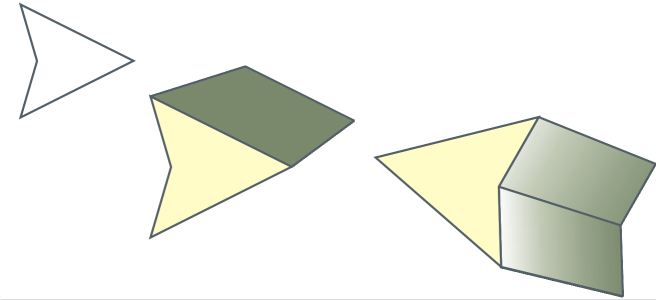You can make objects appear three-dimensional by creating extrusions. You can create extrusions by projecting points from an object and joining them to create an illusion of three dimensions. CorelDRAW also lets you apply a vector extrusion to an object in a group.
After you create an extrusion, you can copy or clone master
You can change an extruded form by rotating it and rounding its corners.
CorelDRAW also lets you remove a vector extrusion.
Bevels
Another way in which you can give an object a three-dimensional appearance is by applying a beveled edge to an extrusion. A bevel creates the illusion that an object’s extruded edges are cut on an angle. You can specify the angle and depth values of the bevel to control the effect.
You can create a bevel effect without extruding an object. For more information, see Create bevel effects.
Extruded fills
You can apply fills to an entire extrusion or only to the extruded surfaces. You can cover each surface individually with the fill, or you can drape the fill so that it blankets the entire object with no breaks to the pattern or texture.
Left to right: a simple shape, the shape with an extruded fill of solid color, the shape with an extruded gradient fill and a rotation applied.
Lighting
You can enhance extrusions by applying light sources. You can add up to three light sources to project toward the extruded object with varying intensity. When you no longer need light sources, you can remove them.
Vanishing points
You can create a vector extrusion in which the lines of the extrusion converge at a vanishing point
You can also give extrusions different vanishing points.
Extrusions with different vanishing points
You can edit the extrusion by using the Extrude docker (Effects Extrude ).
2 .
Click Object and click one of the following:
You can also use the Attributes eyedropper tool To copy effects from one object to another.
Select an extruded object. Click the Extrude rotation button
on the property bar. Drag the extrusion in the direction you want.
Using the Extrude tool
, click an extrusion. Click the vanishing point, and drag in the direction you want.
Using the Extrude tool
, click an extrusion. Drag the slider between the interactive vector handles.
In the toolbox, click the Shape tool
. Drag a corner node along the outline of the rectangle or square.
2 .
Click Effects Clear Extrusion .
You can also remove a vector extrusion by clicking Clear Extrusion on the property bar.
2 .
Click the Extrusion color button on the property bar.
You can apply an unbroken pattern or texture fill to an object by enabling the Drape fills check box before you click the Use object fill button.
3 .
Click the Extrusion bevels button
You can also set the bevel depth and angle by using the Bevel interactive display box Use bevel check box.
You can show only the bevel and hide the extrusion by enabling the Show bevel only check box.
2 .
Click the Extrusion lighting button
Move the Intensity slider next to the numbered check box.
The features documented in the Help are available in the full version of CorelDRAW Graphics Suite 2020. Some features may not be available in this version of the product.
This site works best with JavaScript enabled

![]() Extrude).
Extrude). to copy an extrusion. For more information, see To copy effects from one object to another.
 below the Use bevel check box.
below the Use bevel check box.